
Wine Culture and Information since 2002 - Volume 22
 Wine Culture and Information since 2002 - Volume 22 |
|
Issue 17, March 2004 |
Contents |
|
|
Forgotten Wines of Italy |
|
Italy is usually considered as one of the main countries which traditionally produces wine and was - and still is - an important country in the history of wine making. There are few countries in the world having an enological history as rich as the one of Italy. Despite the origin of wine making in Italy is usually dated back to ancient Greeks times, vine was already present in the country long before their arrival and the ancient local people - in particular Etruscans - were already involved in the production of this beverage. In more than 2000 years of history the number of wines produced in Italy has been pretty high and quality faced moments of absolute prestige - as mentioned by many authors in their writings during the Roman age - as well as moments of absolute decay. In this long period, time has been witness of the birth - and unfortunately of the disappearing - of many renowned wines which made important the areas where they were produced at. Many of these wines uniquely continue to live in the pages of the ancient documents where they were usually praised and esteemed, consigning them to the memory of time and being cause of curiosity among the ones who only heard talking about them. Many others are still produced today, even though with proper “modern” adaptations, and are still famed and appreciated. Other wines are instead facing the risk of disappearing no matter few and determined producers, to whom go our appreciation and esteem, continue to keep the historical wines of their lands and of their ancient traditions alive. How comes some glorious wines of the past and that are still produced do not meet the appreciation and interest of consumers? Maybe taste has changed and therefore some wines having an “ancient” taste are not capable of meeting the canons of modern taste? Of course commercial and promotional factors indisputably play their fundamental role. Maybe it is because these wines having an ancient taste, complicated, rich and certainly not immediate, require lots of attention in order to be appreciated and therefore a “modern” wine, although produced by using disputable methods and made of the right ingredients, is more easily appreciable and direct? Maybe these wines require a higher sensorial effort and therefore, because of laziness and homologation of habits, are considered less interesting and more difficult and hence less attractive? Let's consider, for example, two magnificent wines produced in Sicily and in Sardinia - Marsala and Vernaccia di Oristano - how many wine consumers, honestly, continue to appreciate them, or however had the opportunity and curiosity to taste them at least one time? Nevertheless Marsala has been in the past the only wine capable of being comparable with Port, Madeira and Jerez (Sherry), three wines which made the economic fortune of many merchants of the past and the happiness of countless wine lovers. What about Vernaccia di Oristano? Maybe few people know it is one of the most longeval wines, not only of Italy but also of the world. It can even age for more than 20 years developing complexity and extraordinary richness in aromas and taste like few other wines can afford. Of course, these two wines are not the only ones that could be mentioned - the list could go on with tens of names - however they make a good example of magnificent wines which truly risk to disappear because of the lack of interest. Many producers had to change their production in order to avoid bankruptcy, many of them have quit producing these wines while starting the production of more modern and commercial wines. Their choice is clearly understandable: according to a plain economic point of view it is not wise to make something which does not make any profit, however from a cultural point of view it is a loss for everyone. Of course we have nothing against the wines which are famous - how could we deny the greatness of many of them - anyway as the production and the spreading of “modern” wines are promoted, likewise it should be done the very same for the spreading of these “lesser” wines - we hope their producers do not take offense for having used this adjective - and we cannot accept them to disappear from our history and our glasses. It should be admitted, without offense to anyone, these “ancient” wines are not wines for everyone, they do not have the readiness of many modern wines which can be drunk without any formality and easiness. If we consider again, for example, Marsala and Vernaccia di Oristano, they are not wines that can be drunk thoughtlessly and in a hurry, they are wines which require attention, which require taking a break and with tranquility appreciating and understanding the endless symphony of aromas and tastes originating from the glass. This is a principle, unfortunately, which does not meet the frenetic absurdity of the time we all forced ourselves to in order to live in this modern society rich of paradoxes and of which we all are responsible of. Maybe we have no time, or probably we do not want to have time, to consider and think of those things that could make our life happier and less complicated. It is certainly easier to be attracted by the charm of the explicit and of “all at once”, thoughtlessly and without responsibility, where pressure and hurry do not allow us to notice important things which are neglected just because they asked a little more time and attention. Maybe these wines are victims of this system, too much complicated in order to be understood and too distant from our habits and our times. Nevertheless the richness of a Marsala Vergine and the complexity of a Vernaccia di Oristano, aged for more than ten years, a remarkable time for a white wine, repay all the attention and time dedicated to their appreciation. It is sad to see there are few people out there who are capable of appreciating these kind of wines, who know them and continue to look for them and to support them. To all of them who have never had the pleasure - as well as the privilege - of tasting these kind of wines, we invite them to try this genuine and amazing sensorial experience and we are sure of the fact they will not be disappointed. Finally, wine is culture and its culture is indisputably made of those truly great wines, often forgotten, which allowed enology, not only the Italian one, to walk a successful long way. Let's not forget this.
|
||||
MailBox |
|
In this column are published our reader's mail. If you have any comment or any
question or just want to express your opinion about wine, send your letters to
our editorial or fill in
the form available at
our site.
|
| In a bottle of wine I noticed the term “Meritage”. What does it mean? |
| Deborah Brooks -- Kelseyville, California (USA) |
| The term Meritage was coined in 1988 by a group of producers with the purpose of defining a standard for identifying those American wines produced with traditional Bordeaux grapes. The goal of The Meritage Association consists in the promotion and identification of American wines produced by blending and because they are not produced with at least 75% of a single variety, they cannot show the name of the grape in the label, as stated by the laws in force in the United States of America. This restriction was the cause of the origination of many fantasy names used for the identification of these wines and therefore being cause of confusion. The term Meritage defines, as a matter of fact, an identifiable category to consumers, in which wines must meet specific production and quality requisites. Wines that can make use of the Meritage definition must be produced by blending two or more Bordeaux grape varieties: Cabernet Franc, Cabernet Sauvignon, Carmenère, Malbec, Merlot and Petit Verdot for red wines; Sauvignon Blanc, Sémillon and Muscadelle for white wines. Each one of these grapes can be present in a wine for not more than 90%. Moreover Meritage wines must be produced and bottled in the United States of America, grapes must come from recognized appellation areas and the wine must represent the most prestigious product of the winery and this usually corresponds to the most expensive one as well. |
| Why do bottles of American wine have “contains sulfites” written in the label? Why do they make use of sulfites in American wines? |
| Charles Garrett -- Auburn (Australia) |
| The use of sulfites in enology is a practice common in every wine producing country of the world. In the United States of America, because of specific laws regulating the production and bottling of wine, labels must show some information and warning, including the warning about the presence of sulfites. The practice of “sulfiting” can be done both during the cultivation and the many phases of vinification. During the cultivation vines can be treated with sulfur in order to deter many parasites and diseases. During the wine making process, sulfur dioxide (SO2) is added to the must in order to prevent the formation of bacteria or molds and is added to wine in order to prevent its oxidation and its spoilage, in other words, sulfur dioxide has a stabilizing role. Sulfur dioxide is usually added to wine as a gas or as tablets of potassium metabisulfite, which reacting with wine's acids, creates sulfur dioxide. Sometimes sulfur wicks are burned inside the containers that will keep wine, an operation that originates sulfur dioxide, in order to prevent the formation of molds. During these practices, part of the sulfur dioxide combines with the wine, in this case it will be called fixed sulfur dioxide, which does not originate any smell and therefore does not alter the aromas and taste of wine. Free sulfur dioxide is that part of gas which does not combine with the wine and it is therefore easily perceivable to smell and taste when present in excessive quantities. The maximum quantity of total sulfur dioxide allowed for the production of wine, represented by the sum of fixed and free ones, is usually set by specific laws in force in the many wine producing countries. It should be noticed excessive quantities of sulfites can be cause of allergic reactions in sulfites sensitive individuals and the use of sulfites is pretty common in the food industry, therefore it is not something which is uniquely related to the production of wine. |
CaliforniaThe famous American state made wine one of its most characteristic activities. Its wines are known all over the world and in this area it is produced the majority of wine in the United States of America |
|
There are many things commonly associated to California, the renowned American state of the western coast, and one of these is certainly wine. Despite the production of wine is far more recent than the one of Europe, California is now considered among the most important wine producing areas of the world and, it is not by chance, its producers and pretty open minded to innovation and to experimentation of new wines and methodologies. This is probably because of the lack of a long enological history, as opposed to Europe, and therefore the fact of not having any “traditional” model to follow, the production is generally more free and enterprising. California can be defined as the “big tank of American wine”, as it is right in this state there is the higher production of the United States of America. More than 90% of American wine is produced in California. The influence of California in the wine production of the other American states has always been, and continues to be, a reference model and it is right in this state are being created the wines which influence the production style of the country. It should be remembered the Californian style is, in many aspects, based on the French one, in particular on Bordeaux, Bourgogne and Rhône wines. The acreage destined to the culture of vine is pretty high, about 1750 square kilometers (about 432,500 acres), and comprises the majority of Californian territory. Despite the production of wine in California began few centuries ago, facing pretty alternating periods of good fame and period of recession, both because of natural events, such as phylloxera, and political events, such as prohibitionism in the beginning of the last century, the radical change which originated the present condition took place only in the 1960's.
The success of Californian enology is probably because of its recent enological history: the absence of specific traditions to keep or to follow made possible the adoption of modern and innovative practices that in the short period of few tens of years have allowed to reach remarkable results. Of course the success of California is not only determined by productive choices but also, and in particular, to the favorable climatic, geological and environmental conditions. California is often considered as the “Mediterranean of the New World”, an ideal land suited to the cultivation of vine and to the production of wine and facts seems to confirm this hypothesis. The success of Californian wines is also because of the huge economic investments done in the wine industry and that allowed to reach excellent results. In the short period of time of few years, in the middle of the 1970's, Californian wines conquered notoriety in Europe and often, in the wine fairs and contests, they proved to be superior to the wines they used as a model: French wines. Even grapes cultivated in this state clearly reflect the productive choices for California wine. The lack of autochthonous varieties - saved Zinfandel, known in the state since the beginning of the nineteenth century - grapes used for Californian wines are mainly international grapes and in lesser part Italian grapes. The most common grapes in California are Chardonnay, as for white grapes, and Cabernet Sauvignon for red berried grapes. The main white berried grapes of California are Chardonnay and Sauvignon Blanc, however are also cultivated Riesling, Pinot Blanc, Pinot Gris, Sémillon, Viognier, Chenin Blanc, Gewürztraminer, Colombard, Marsanne, Roussanne and Muscat Blanc. The most important red berried grapes of California are Cabernet Sauvignon, Zinfandel, Merlot, Pinot Noir and Syrah followed by Cabernet Franc, Carignan, Grenache Noir, Malbec, Mourvèdre, Petite Sirah, Petit Verdot, Barbera and Sangiovese. Zinfandel, once famous in the United States vinified as a white wine (White Zinfandel), is one of the most ancient grapes of California. It seems Zinfandel was known in California since the beginning of nineteenth century and many believed it to be an autochthonous grapes. Recent investigations on DNA revealed it is genetically equal to Primitivo. Further investigations about its genetic characteristics revealed this grape has a strong and strict similarity to Plavac Mali, a grape originating from Dalmatia, therefore considered as the ancestor of both Zinfandel and Primitivo. In California is virtually produced any style of wine, from dry whites to reds, from sweets to interesting classic method sparkling wines.
|
||||||||
|
Californian wines are classified according to the quality system in force in the United States of America in which is set the territorial division of wine areas. The system is called AVA (American Viticultural Areas). The American quality system is often subject of criticism because of the low number of norms about the wine making and viticultural practices, a system which is usually considered as vague and permissive but it certainly let producers to make use of a higher personal initiative. The system generally guarantees that grapes used for the production of a wine were cultivated in a specific area and present in a wine for at least 75% of the total quantity. In the system are not set categories of increasing level of quality, such as, for example, in France or in Italy, however the system uses divisions that define the surface of the wine area according to the administrative divisions of the country. The appellations recognized by the AVA are as follows: American or United States, Multi-State Appellation, State Appellation, Multi-County Appellation and County Appellation.
|
|
Napa Valley is certainly the most famous wine area in California. This area, which is located about 90 kilometers (about 56 miles) north-east from San Francisco, despite of its fame and importance in the wine scene of the country, produces about 4% of the total production of California. The success of the wines of Napa Valley are because of its environmental conditions as well as the will and determination of one of its most renowned wine producers: Robert Mondavi. The most common grape in Napa Valley's vineyards is certainly Cabernet Sauvignon used to produce wines of excellent quality. Among white wines are interesting the ones produced with Chardonnay, the most common grape in this area, and Sauvignon Blanc, whereas for red wines, besides Cabernet Sauvignon, interesting wines are produced with Merlot and Zinfandel. It should be however remembered American wines showing in the label the name of just one grape - the so called mono varietals - can contain up to 25% of other varieties, and this is the most common practice for the wine making in California. Napa Valley is classified as AVA, however inside this territory are defined other wine areas of which the most important ones are Atlas Peak, Howell Mountain, Mount Veeder, Oakville, Rutherford, Spring Mountain and Stags Leap District. In Napa Valley, as well as in other Californian areas, there is also an interesting production of classic method sparkling wines, usually defined as methode champenoise. The production of sparkling wines is pretty interesting and involves not only local producers but also some wineries from Champagne which bought lands in Napa Valley with the explicit goal of producing sparkling wines. The result is a remarkable production which was capable, with plain facts, to deny the prejudices that for many years have interested Californian sparkling wines.
|
||||
|
Not far from San Francisco and to the left of Napa Valley, there is Sonoma, one of the most important wine areas in California. Because of the vicinity to the Pacific ocean coast, the climate of Sonoma is pretty different from the one of Napa Valley. The presence of fog and sun, cool nights and warm days - conditions pretty frequent in this area - influence, of course, the characteristics of the wines produced here. In Sonoma are virtually cultivated all the grape varieties common in California and no one of them particularly distinguishes the area, however Sonoma is pretty renowned for its white wines produced with Chardonnay and for red wines produced with Cabernet Sauvignon and Pinot Noir. Moreover, in this area are also produced interesting wines with Zinfandel, Syrah, Petite Syrah and Viognier as well as an interesting production of classic method sparkling wines. Inside the Sonoma County are defined other AVAs of which the most important ones are Alexander Valley, Russian River Valley (which includes Green Valley and Chalk Hill AVAs), Dry Creek Valley and Sonoma Valley (which includes Sonoma Mountain AVA). Alexander Valley is certainly the most famous one of them all, in particular for its wines made of Cabernet Sauvignon and Chardonnay. Russian River Valley, thanks to its cooler climate, is famous for its wines made of Pinot Noir and Chardonnay and, in particular, for its interesting classic method sparkling wines, whereas Dry Creek Valley is pretty renowned for its wines made of Zinfandel. The most interesting wines of Sonoma Valley and Sonoma Mountain are produced with Cabernet Sauvignon, Pinot Nero and Chardonnay grapes.
|
|
The wine area of Carneros - whose vineyards are partly located in the Sonoma County and partly in the Napa County - thanks to its climatic and productive characteristics is, as a matter of fact, a truly interesting area in the enological scene of California. Carneros is located in the San Pablo Bay - the northern area of San Francisco Bay - and thanks to its cool climate, the area is considered among the most interesting ones and in particular for Chardonnay and Pinot Noir grapes, of which the majority is used for the production of classic method sparkling wines. Carneros also produces interesting dry wines with the same grapes and with truly remarkable and interesting results. A grape which is progressively getting more and more common in Carneros is Merlot, whereas as for white grapes Pinot Blanc is getting pretty common as well. Thanks to its climatic and environmental conditions, Carneros attracted many sparkling wines producers from the “Old World”, in particular from France and Spain, who started in this area the production of interesting classic method sparkling wines.
|
|
Mendocino and Lake County are the most northern wine areas of California and represent, in many aspects, the most interesting wine areas of the state. Not only the climate is cooler - a condition which favored the spreading of Chardonnay and Pinot Noir - but here producers seem to be more open minded towards other grape varieties with good results. The cool climate, in particular in Mendocino, has also favored a good production of classic method sparkling wines. In these two areas are also present some Italian varieties, including Fiano, Montepulciano and even Arneis, as well as other varieties, less common in other parts of California, such as Gewürztraminer, Riesling, Sauvignon Blanc, Pinot Blanc, Petite Syrah and Grenache Noir. Other interesting grapes of these areas are Zinfandel, with which are produced interesting wines, and Syrah. Mendocino is famous for having adopted practices of organic viticulture and sustainable agriculture, the first wine area of California which believed in these forms of viticulture.
|
|
In the eastern part of California is located Sierra Foothills AVA, a pretty large area of about 250 square kilometers (about 61,800 acres) and the most interesting wine areas here are El Dorado AVA and Amador County. El Dorado AVA - once renowned, it seems, for the presence of gold which attracted many people - is a mountainous area with a cool climate and the main grapes cultivated here are Syrah, Zinfandel and Petite Syrah, however here are also found Barbera, Grenache Noir and Mourvèdre. The Amador County is famous for Zinfandel which is produced by some wineries with remarkable results, moreover here are also produced wines with Sauvignon Blanc, Cabernet Sauvignon, Chardonnay and other Italian varieties such as Sangiovese and Barbera. Not far from San Francisco, to the south, there is Livermore Valley, one of the most ancient wine areas of California, not very large but however interesting. The most important grapes of this area are Sémillon, Sauvignon Blanc, Chardonnay, Cabernet Sauvignon, Petite Syrah and Zinfandel.
|
|
The Central Coast is the largest wine area of California and goes from San Francisco to Los Angeles. In this large area are located pretty famous and interesting AVAs such as Santa Clara Valley, Santa Cruz Mountains, Monterey County, Mount Harlan, Carmel Valley, Chalone, Paso Robles, York Mountain, Edna Valley, Arroyo Grande, Santa Maria Valley and Santa Ynez Valley. The most typical white berried grapes of these areas are Chardonnay, Riesling, Viognier as well as a small part of Muscat Blanc - here known as Muscat Canelli - and Orange Muscat. Among the red berried grapes there are Cabernet Sauvignon and Merlot, however here are also cultivated Grenache Noir, Mourvèdre, Syrah, Cinsaut, Pinot Noir and Zinfandel.
|
MerlotThe famous red grape is one of the most spread and known in the world. Fundamental element in many wines, Merlot is also vinified alone with excellent results, however there are also mediocre and disappointing examples |
|
Among the most common and spread international grapes in the world, as well as being one of the most common terms known to wine lovers, there is Merlot. From its homeland, Bordeaux, Merlot walked a long way and it spread everywhere also thanks to its qualities and, last but not the least, to the unmistakable style it gives to its wines. For many Merlot is what it is Chardonnay for white grapes: a grape which ensures good yields and a good versatility in the wine making practices. Merlot can make, and this is of course true for every grape, truly modest and ordinary wines, virtually produced in every country where it is found, as well as wines of superb elegance, such as the famous examples produced at Pomerol and Saint-Emilion in the Bordeaux area. The most common use of Merlot is in the composition of assembled wines, blended to other grapes it is always successful in adding its character and its contribution. A classical example where Merlot is used together with other grapes is the one of Bordeaux, in particular in the Médoc area, where it is mainly blended with Cabernet Sauvignon and Cabernet Franc. The use of Merlot in blends is a very common practice in other countries as well, such as Italy where it is frequently added to traditional grapes like Sangiovese, Montepulciano and Nebbiolo. Merlot is also used alone, as a mono varietal wine and without adding any other grape, and when it is cultivated in favorable conditions and properly vinified, it is capable of remarkable results. Thanks to its “round” character, Merlot gained the support of many wine lovers, but also lots of detractors because of the high number of wines where it is being used worldwide. For this reason Merlot is often blamed for being the main responsible of the homologation of many red wines having the so called international taste.
Why did Merlot spread everywhere and meet the taste of so many people in the world? The reason could be explained by two fundamental factors. The fame of French wines, certainly deserved, has been for years the reference model for the majority of wine producers all over the world. The reason for success of French wines was mainly believed to be because of the grapes they used, most of the times without considering the fact that environmental and climatic conditions of France were a fundamental factor as well and, first of all, unique, as well as they are unique the conditions of every other place of the world. Convinced that the success could be ensured by just using French grapes - including Merlot - the spreading was pretty fast and it virtually reached every wine producing country of the world. Sad to admit, this also favored the production of huge quantities of mediocre wines that were sold at high prices only because they were produced with these grapes. Even worse to admit, this practice is still frequent now and some producers speculate on the price of wine when they make use of international grapes, including Merlot. The other reason that ensured the success of Merlot is its organoleptic characteristics, in particular its taste. Merlot is a grape with a pretty low content in acid, a pretty modest quantity of tannins, and the wines produced with this grape can have a percentage of alcohol higher than many other wines. These three characteristics give Merlot wines a round, soft and velvety taste, that is those qualities which easily meet the taste of a pretty high number of people. These characteristics are usually perceived also in those wines where the grape is present, a factor that can be appreciable even when Merlot is used in modest quantities. Moreover wines produced with Merlot usually tend to age faster than others, such as the ones produced with Cabernet Sauvignon, therefore they become more pleasing to drink in less time. Merlot is usually appreciated by many wine makers who like to use it because of its pretty versatile qualities and can ensure good results in most of the cases. It should be noticed this grape is often used in those wines which are too much “rough” and “harsh” in order to make them more drinkable and soft and the effects are most of the times amazing. Merlot is also particularly suited for the aging in cask - and this is the most frequent treatment for this grape - and it often takes advantage of the aromas and tastes passed from wood which give a higher complexity to its “relatively simple” character. In case what we have written so far made readers think of Merlot as an “universal” grape capable of working real enological miracles - and there are many to believe this - it should be remembered Merlot is no exception to the fundamental rules of viticulture and wine making. In other words not all the Merlot wines are worth of attention, as always, a grape, alone, does not ensure a good result. This is confirmed by that ocean of wine made of Merlot and that, frankly speaking, can be just considered as mediocre. The good news is represented by those many wines produced with Merlot of magnificent and absolute value. Two conditions - it should be remembered - that are applicable to every other grape. According to a viticultural point of view, Merlot is a grape which ripens earlier than other varieties, does not stand to the effects of rain just before harvesting and it is sensible to the development of molds. By considering its wide spreading in the world, Merlot has good capacities of adaptability in many climatic conditions, however it prefers areas with a pretty cool climate where it produces the best results, such as in the areas of Pomerol and Saint-Emilion in Bordeaux. Merlot seems to prefer a clay and humid soil, however there are also good results obtained in other types of soils, whereas an excessively drained soil greatly affects the development of bunches. The aging potential of its wines is generally of 6 years, a period that can also be longer than ten years in the best conditions. Thanks to its qualities, wines produced with Merlot ages earlier than other wines and therefore they become drinkable and ready in less time.
|
||||||||
|
The range of colors that can be observed in wines produced with Merlot are, of course, the typical colors found in red wines. However, because of a more rapid aging, these wines generally tend to show nuances of garnet red just after three or four years. The variation towards nuances of garnet red is obviously more rapid and visible in wines of low quality, produced with pretty high yields in vineyards, whereas the ones produced with quality procedures, Merlot shows firm ruby red nuances even after more years. Transparency in Merlot wines is not pretty low - a characteristic, once again, strongly influenced by viticultural practices - and it is usually more transparent than a Cabernet Sauvignon or a Sangiovese. The color of a Merlot ready to drink is generally of brilliant ruby red and not very deep with nuances of the same color and, occasionally, slightly purple red.
|
|
Merlot is a grape having pretty moderate aromatic characteristics and therefore its wines are usually aged in cask - most of the times in new oaks - with interesting results which easily meet the taste of consumers. The range of typical aromas of Merlot resemble red and black berried fruits, however - just like any other grape - the aromatic range is influenced by climatic, viticultural and environmental conditions. Wines produced with Merlot grape and cultivated in areas having a cool climate or harvested before reaching full ripeness, are usually characterized by aromas resembling vegetables and herbs, such as bell pepper and bruised leaf, as well as aromas of fruit, in particular red berried fruits, such as raspberry. Wines produced in areas having a warm climate, or with grapes that reached full ripeness, are characterized by stronger and cleaner aromas of fruits, where can be perceived aromas of black berried fruits such as blueberry, blackberry, black cherry and plum, as well as aromas of jams made of the same fruits. In these wines can also be perceived aromas of flowers and in particular the aroma of violet. Merlot can also have typical balsamic aromas - such as eucalyptus and menthol - a characteristic which is more evident in wines produced in areas having cooler climates or with not perfectly ripe grapes. The aromatic evolution of Merlot is pretty interesting and with time it can also get interesting aromas of game, caramel, mushrooms, truffle, spices while greatly emphasizing aromas of fruits evolved into rich jams. In some cases it can also develop aromas of butter and keep vegetal aromas and mown grass as well as balsamic aromas of eucalyptus and menthol.
|
||||
|
The taste of wines produced with Merlot is certainly emphasized by the most identifiable and typical character of the grape, a quality which is usually appreciated by consumers and by its supporters. Thanks to the low quantity of acids and to the moderate contents in tannins, wines produced with Merlot grape are generally round, soft and velvety to the palate. The content in alcohol is pretty high and this factor contributes to the overall roundness of the wine. These gustatory characteristics are generally appreciable even when Merlot is blended with other grapes. In general terms this is the most frequent reason for which this grape is widely used in enology: the presence of Merlot always gives wine a rounder and less aggressive character, in other words, more drinkable. This gustatory characteristic of Merlot is however strongly influenced by the way the grape was cultivated and vinified. The round character of Merlot is less perceivable in ordinary and light wines, whereas it can also have a velvety, caressing and enchanting character in the most bodied and structured styles.
|
|
The homeland of Merlot is Bordeaux where the grape represents, alone, more than the half of the viticultural production of the region. The best examples of wines produced with Merlot grapes - or however with a relevant percentage - are Saint-Emilion and Pomerol. In these two areas, thanks to the local climate, the aromatic character of the grape is extraordinarily expressed by a richness which goes from vegetables to ripe fruits and jams. Other good examples of wines produced with Merlot in the Bordeaux area are the ones from Fronsac, Canon Fronsac, Côtes de Bourg and Côtes de Blaye. Merlot is very common in Italy as well, where it is used both blended with other grapes and alone. The grape is pretty common in the north-eastern area of the country, in Trentino, Alto Adige, Veneto and, in particular, Friuli Venezia Giulia where it is used to make interesting wines. Other European areas where interesting examples of Merlot wines are produced include Switzerland and, in less quantities, Spain, Bulgaria and Hungary. In the so called “New World” Merlot is widely present and used in every country. The production of Merlot wines in California is pretty high and, above all, pretty varied. In this state are produced Merlots with pretty wide quality levels, from ordinary and modest wines up to excellent examples, in particular the ones produced at Napa Valley and Sonoma. The state of Washington is certainly an interesting producer of Merlot wines, also thanks to its favored climatic conditions more suited to this grape than in California, and the style clearly reflects the one of Bordeaux. In South America, Chile is the country which offers the best examples of Merlot wines, in particular the ones produced in the Rapel Valley. Even South Africa has a pretty remarkable production of Merlot wines and the best examples are the ones produced in the so called “Cape” area, in particular Paarl and Stellenbosch. In Australia Merlot is not very used alone, however even in this country there are good examples. New Zealand produces good Merlots and the most interesting examples are the ones from Hawkes Bay.
|
Wines of the Month |
|
|
|
Score legend Prices are to be considered as indicative. Prices may vary according to the country or the shop where wines are bought |
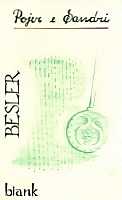
|
|
Besler Biank 2001 |
|
| Pojer & Sandri (Italy) | |
| Grapes: Pinot Blanc, Riesling, Sauvignon Blanc, Incrocio Manzoni, Kerner | |
| Price: € 12,00 | Score: |
| This wine shows a brilliant greenish yellow color and nuances of greenish yellow, very transparent. The nose reveals good personality with intense, clean, pleasing, elegant and refined aromas which start with good hints of elder and peach followed by intense aromas of pineapple, banana, apple, litchi, pear, broom and pleasing hints of sage and bell pepper. In the mouth has good correspondence to the nose, a crisp attack and however well balanced, good body, intense flavors, pleasing crispness. The finish is persistent with good flavors of pineapple, peach, pear and litchi. A well made wine. Besler Biank ages for 12 months in cask. | |
| Food Match: Pasta and risotto with fish, Mushrooms soup, Roasted fish, Crustaceans | |
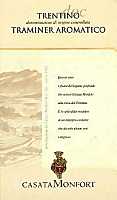
|
|
Trentino Traminer Aromatico 2002 |
|
| Casata Monfort (Italy) | |
| Grapes: Gewürztraminer | |
| Price: € 7,90 | Score: |
| The wine shows a brilliant straw yellow color and nuances of straw yellow, very transparent. The nose reveals intense, clean and pleasing aromas which start with hints of citronella and peach followed by aromas of hawthorn, broom, apple, honey, pear and plum. In the mouth has good correspondence to the nose, a crisp attack and however balanced, good body, intense flavors. The finish is persistent with flavors of peach and plum. This wine ages in steel tanks for 5 months. | |
| Food Match: Sauteed fish, Pasta and risotto with fish and mushrooms, Mushrooms soups | |

|
|
Monfort Rosa 2002 |
|
| Casata Monfort (Italy) | |
| Grapes: Moscato Rosa | |
| Price: € 12,50 | Score: |
| The wine shows a pale ruby red color and nuances of deep pink, moderate transparency. The nose reveals intense, clean and pleasing aromas that start with hints of rose and strawberry followed by aromas of raspberry, black cherry, plum and hints of dried violet and almond. In the mouth has good correspondence to the nose, a slightly crisp attack and however balanced, pleasing sweetness, good body, intense flavors, pleasing. The finish is persistent with flavors of strawberry and raspberry. This Moscato Rosa ages for 10 months in steel tanks and for 3 months in bottle. | |
| Food Match: Fruit cakes, Desserts | |
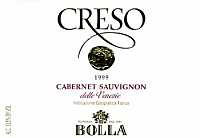
|
|
Creso 1999 |
|
| Bolla (Italy) | |
| Grapes: Cabernet Sauvignon (85%), Corvina (15%) | |
| Price: € 21,00 | Score: |
| The wine shows a brilliant ruby red color and nuances of ruby red, moderate transparency. The nose reveals good personality with intense, clean, pleasing, refined and elegant aromas which start with hints of black cherry and black currant followed by aromas of blueberry, licorice, tobacco, dried violet, vanilla and hints of black pepper and cocoa. In the mouth has good correspondence to the nose, a slightly tannic attack and however balanced by alcohol, good body, intense flavors, good tannins. The finish is persistent with flavors of black cherry, black currant and blueberry. This wine ages for 21 months in barrique, for 5 months in cask followed by one year of aging in bottle. | |
| Food Match: Braised and stewed meat with mushrooms, Roasted meat, Broiled meat and barbecue | |
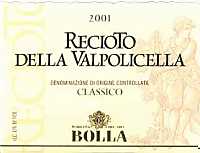
|
|
Recioto della Valpolicella Classico 2001 |
|
| Bolla (Italy) | |
| Grapes: Corvina, Corvinone | |
| Price: € 17,00 | Score: |
| This Recioto shows a deep ruby red color and nuances of purple red, little transparency. The nose reveals good personality with intense, clean, pleasing and elegant aromas which start with hints of black cherry jam, blackberry jam and dried plum followed by aromas of raspberry, blueberry jam, vanilla, licorice, chocolate, dried violet and hints of cinnamon, clover and peach. In the mouth has good correspondence to the nose, a slightly tannic and sweet attack however balanced by alcohol, good body, intense flavors, pleasing. The finish is persistent with flavors of dried plum, black cherry jam and peach. This wine ages for 4 months in barrique. | |
| Food Match: Fruit cakes, Piquant and hard cheese | |
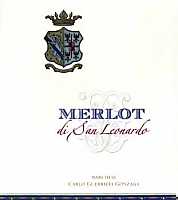
|
|
Merlot di San Leonardo 2001 |
|
| Tenuta San Leonardo (Italy) | |
| Grapes: Merlot | |
| Price: € 9,80 | Score: |
| The wine shows an intense ruby red color and nuances of ruby red, little transparency. The nose reveals intense, clean, pleasing and elegant aromas which start with hints of black cherry and black currant followed by aromas of blueberry, raspberry, vanilla and violet. In the mouth has good correspondence to the nose, a slightly tannic attack and however well balanced by alcohol, good body, intense flavors, good tannins, agreeable. The finish is persistent with flavors of black cherry and black currant. This Merlot ages in cask for 18 months and at least 4 months in bottle. | |
| Food Match: Sauteed meat with mushrooms, Stuffed pasta, Broiled meat and barbecue | |
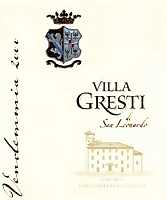
|
|
Villa Gresti 2000 |
|
| Tenuta San Leonardo (Italy) | |
| Grapes: Merlot | |
| Price: € 36,00 | Score: |
| This wine shows an intense ruby red color and nuances of ruby red, little transparency. The nose reveals good personality with intense, clean, pleasing, elegant and refined aromas which start with hints of black cherry and black currant followed by good and intense aromas of blueberry, raspberry, plum, vanilla, cyclamen, licorice and hints of cocoa, eucalyptus and toasted wood. In the mouth has very good correspondence to the nose, a slightly tannic attack and however well balanced by alcohol, full body, intense flavors, good tannins, agreeable. The finish is persistent with good flavors of black cherry, blueberry and raspberry. A very well made wine. Villa Gresti ages for 12-14 months in barrique followed by at least 12 months of aging in bottle. | |
| Food Match: Roasted meat, Braised and stewed meat, Game, Hard cheese | |
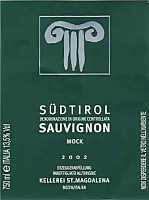
|
|
Alto Adige Sauvignon Mock 2002 |
|
| Cantina Santa Maddalena (Italy) | |
| Grapes: Sauvignon Blanc | |
| Price: € 10,50 | Score: |
| The wine shows a brilliant greenish yellow color and nuances of greenish yellow, very transparent. The nose reveals intense, clean, pleasing, refined and elegant aromas that start with hints of peach, litchi and pineapple followed by aromas of acacia, pear, broom, banana, apple, bell pepper, box and elder. In the mouth has very good correspondence to the nose, a crisp attack and however balanced by alcohol, good body, intense flavors, agreeable. The finish is persistent with flavors of peach, litchi and pear. A well made wine. | |
| Food Match: Roasted and broiled fish, Pasta and risotto with fish and vegetables, Crustaceans | |
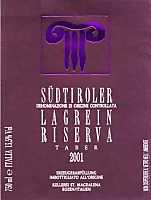
|
|
Alto Adige Lagrein Riserva Taber 2001 |
|
| Cantina Santa Maddalena (Italy) | |
| Grapes: Lagrein | |
| Price: € 22,00 | Score: |
| The wine shows a deep ruby red color and nuances of ruby red, little transparency. The nose reveals good personality with intense, clean, pleasing, elegant and refined aromas which start with hints of black cherry and blueberry followed by good aromas of raspberry, cyclamen, blackberry, plum, violet, vanilla, licorice and pleasing hints of cocoa and coriander. In the mouth has very good correspondence to the nose, a slightly tannic attack and however well balanced by alcohol, full body, intense flavors, good tannins. The finish is persistent with good flavors of black cherry, plum and blackberry. A well made wine. This Lagrein ages for one year in barrique. | |
| Food Match: Roasted meat, Braised and stewed meat, Hard cheese | |
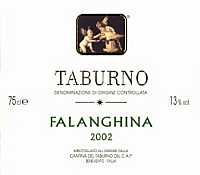
|
|
Taburno Falanghina 2002 |
|
| Cantina del Taburno (Italy) | |
| Grapes: Falanghina | |
| Price: € 5,00 | Score: |
| The wine shows an intense greenish yellow color and nuances of greenish yellow, very transparent. The nose denotes intense, clean, pleasing and refined aromas that start with pleasing hints of pear and peach followed by aromas of hawthorn, acacia, broom, pineapple, litchi, apple and hints of banana. In the mouth has good correspondence to the nose, a crisp attack and however balanced by alcohol, delicate, intense flavors, agreeable. The finish is persistent with good flavors of peach, pear and litchi. | |
| Food Match: Fish appetizers, Boiled fish and crustaceans, Risotto with crustaceans and vegetables | |
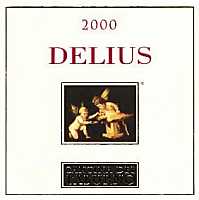
|
|
Delius 2000 |
|
| Cantina del Taburno (Italy) | |
| Grapes: Aglianico | |
| Price: € 16,00 | Score: |
| This wine shows an intense ruby red color and nuances of garnet red, little transparency. The nose reveals intense, clean, pleasing and refined aromas that start with hints of plum, black cherry and vanilla followed by aromas of blueberry, blackberry, violet, licorice and carob. In the mouth has good correspondence to the nose, a slightly tannic attack and however balanced by alcohol, good body, intense flavors, good tannins. The finish is persistent with flavors of plum, black cherry and blueberry. Delius ages for 12 months in barrique. | |
| Food Match: Stewed and braised meat with mushrooms, Roasted meat, Game, Hard cheese | |
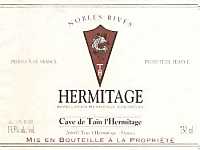
|
|
Hermitage Blanc Nobles Rives 2000 |
|
| Cave de Tain l'Hermitage (France) | |
| Grapes: Marsanne | |
| Price: € 46,20 | Score: |
| The wine shows a pale golden yellow color and nuances of straw yellow, very transparent. The nose reveals good personality with intense, clean, pleasing and refined aromas which start with good hints of apple, pear and broom followed by aromas of walnut-husk, hawthorn, hazelnut, plum, toasted wood and pleasing mineral hints. In the mouth has good correspondence to the nose, a crisp attack and however well balanced by alcohol, good body, intense flavors, pleasing roundness. The finish is persistent with good flavors of pear and apple. Part of this wine is fermented in barrique. | |
| Food Match: Crustaceans, Roasted fish, Sauteed meat with mushrooms, Roasted white meat | |

|
|
Hermitage Rouge Nobles Rives 2000 |
|
| Cave de Tain l'Hermitage (France) | |
| Grapes: Syrah | |
| Price: € 48,70 | Score: |
| This wine shows an intense ruby red color and nuances of garnet red, little transparency. The nose reveals intense, clean, pleasing, refined and elegant aromas which start with hints of black cherry, plum and black pepper followed by aromas of blueberry, blackberry, black currant, tobacco, vanilla, licorice and pleasing hints of chocolate. In the mouth has good correspondence to the nose, a slightly tannic attack and however balanced by alcohol, good body, intense flavors, good tannins. The finish is persistent with hints of black cherry, plum and blueberry. A well made wine. This Hermitage ages in barrique for 18 months. | |
| Food Match: Braised and stewed meat with mushrooms, Roasted meat, Hard cheese | |

|
|
Greco di Tufo Devon 2002 |
|
| Antonio Caggiano (Italy) | |
| Grapes: Greco Bianco | |
| Price: € 20,00 | Score: |
| This wine shows a pale golden yellow color and nuances of straw yellow, very transparent. The nose denotes good personality with intense, clean, pleasing and refined aromas which start with hints of plum and apple followed by good aromas of orange, hawthorn, broom, litchi, hazelnut, pear, ripe peach and pleasing hints of lavender. In the mouth has good correspondence to the nose, a crisp attack and however well balanced by alcohol, good body, intense flavors, agreeable. The finish is persistent with flavors of plum, apple and pear. A well made wine. Devon ages in cask for 3-4 months. | |
| Food Match: Crustaceans, Broiled fish, Pasta and risotto with fish and vegetables | |
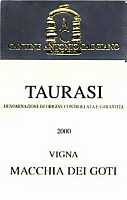
|
|
Taurasi Vigna Macchia dei Goti 2000 |
|
| Antonio Caggiano (Italy) | |
| Grapes: Aglianico | |
| Price: € 40,00 | Score: |
| This Taurasi shows an intense ruby red color and nuances of ruby red, little transparency. The nose reveals personality with intense, clean, pleasing, elegant and refined aromas that start with good hints of blackberry, black cherry macerated in alcohol and violet followed by intense aromas of blueberry, plum, tobacco, licorice, vanilla, chocolate and pleasing hints of cinnamon, clover and menthol. In the mouth has good correspondence to the nose, a tannic attack and however well balanced by alcohol, full body, intense flavors, powerful. The finish is very persistent with long and intense flavors of blackberry, black cherry and plum. A great wine. This Taurasi ages in barrique for 12-18 months followed by 18 months of aging in bottle. | |
| Food Match: Game, Braised and stewed meat, Roasted meat, Hard cheese | |
San Leonardo: Vertical TastingWe had a vertical tasting of four recent vintages of the famous Tenuta San Leonardo's San Leonardo. A cult wine of extraordinary class and wonderful elegance, a genuine poetry of aromas and tastes which are repeated every year |
|
Class, class as well as superb class joined to a magnificent elegance. In these words it could be summarized the personality of San Leonardo, the renowned wine produced by Tenuta San Leonardo at Borghetto all'Adige, Trentino (Italy) and result of the blend of three wines, vinified and aged separately: Cabernet Sauvignon, Cabernet Franc and Merlot. Tenuta San Leonardo, since many years at the top of Italian enology, and certainly of worldwide enology as well, is always distinguished for the choice of producing few types of wines but certainly of excellent quality. Among them San Leonardo every year obtains the highest awards and the appreciation of the ones who have the pleasure of tasting it. What particularly impresses of San Leonardo is its indisputable class and elegance, a sequence of intense and refined aromas which are noticed for their cleanness and harmony. Even the taste of this wine confirms and augment its magnificent class: an excellent balance, smooth and pleasing tannins that however contribute to the remarkable structure of this great wine. The 1995, the oldest of the four wines tasted, shows after 8 years, a pretty short period of time if compared to its potentialities, aromas and tastes that make this wine to be considered in its first stage of evolution, and certainly appreciable already. The 1996 is impressive for the richness of the many aromas, and just like the other ones, has an extraordinary elegance, harmony and cleanness. The 1997 too is wonderful, with its precise aromas and, first of all, with its extreme agreeability to the taste, smooth, round, caressing and absolutely balanced. Finally, the 1999, the youngest of the fours, seems to promise a superb evolution and aging, with its young four years convinces for the long sequence of elegant aromas and for its gustatory agreeability: a great wine of rare elegance. Another positive characteristic of the San Leonardos we tasted is their very long taste-olfactory persistence: a rare aspect that only few magnificent wines can have. Whether San Leonardo is a great wine is something everyone knows and the words that can be said - and that have been said already - about this wine are not enough to describe its magnificent class and elegance: an endless tale that only senses can tell.
|
||||||||||||||||||||||||||||||||||||||||||||||||||||||||
Accademia dei RacemiOriginated by an ambitious project of revaluating the local Apulian grapes, the dynamic winery Accademia dei Racemi has contributed in few years to change the enological scene of Apulia |
|
Accademia dei Racemi was established in 1998 by Gregory Perrucci and his wife Elisabetta Gorla in the aim of revaluating the enological heritage of Apulia and in particular the local grapes that, at those times, seemed to be destined to the production of “bulk wines” only. Accademia dei Racemi is an organization which groups passionate viticulturists, agronomists and wine makers with the goal of promoting the production of quality wines made in Apulia. Among the duties there is also the one of selecting the most interesting and promising sites and vineyards of the region, involving their proprietors in this project while assisting them in the viticultural and wine making practices by offering the help of qualified wine makers and technicians. The work of Accademia dei Racemi is particularly focused on the local varieties, among them Primitivo, Negroamaro and Malvasia Nera, as well as less known varieties such as Susumaniello and Ottavianello, a variety known in France as Cinsaut. In just five years Accademia dei Racemi has significantly contributed to the revaluation of the enological dignity of Apulia - a region with one of the most ancient enological traditions of Italy - and thanks to specific researches and remarkable efforts, it contributed to the revaluation of local varieties, including the now famous Primitivo. Ten years ago or so, Primitivo was simply cultivated with the purpose of producing bulk wines to be destined to other Italian and European regions, and this seemed to be its inexorable and unjust destiny. The initial goal of Accademia dei Racemi was to revaluate this grape, a goal that is now fully accomplished. The will of promoting Primitivo to the levels it certainly deserved was the reason of a research done by a group of experts who initially had to face a reality that was capable of making neutral and alcoholic wines only, that is products that could be easily sold as bulk wines.
Today the wineries represented by Accademia dei Racemi are Pervini, Sinfarosa, Tenute Pozzopalo, Felline, Masseria Pepe and Casale Bevagna, wineries which offer a very good selection of wines made of Primitivo. The history of this grape is rather interesting and the researches done have finally allowed to clear the doubts about this powerful red grape seemed to conceal in every berry. The case “Primitivo” began to catch the attention of wine lovers and producers when it was discovered it was genetically equal to Zinfandel, a red berried grape very common in California. The paradox was that in California were produced wines with Zinfandel that were considered of high quality, whereas Primitivo was simply considered as a grape suited for the production of bulk wines. Aware of the potentialities of Primitivo, both because of historical and local traditions and because of the confirmation provided by Zinfandel, Accademia dei Racemi was convinced more than ever to the revaluation of this grape. Further researches have proved that both Primitivo and Zinfandel are grapes of Croatian origin and are genetically equal to Plavac Mali. Researches have also discovered that all these grapes derive from a unique progenitor, Zagarese, originating from the Balkans and probably introduced in Apulia at the end of the seventeenth century by some Slav people migrated to the region. Convinced of the potentialities of Primitivo and of its enological tradition in the Apulian territory, Accademia dei Racemi started a project also thanks to the help of a team of experts and collaborators, each one of them determined to accomplish the goal of revaluating and giving back the right dignity to Primitivo. In the rooms of the Cooperative Cellar was created a research and micro-vinification laboratory in order to study and evaluate the characteristics of the many crus of Primitivo di Manduria, also thanks to the contributions of producers who conferred Accademia dei Racemi a small part of their vineyards. This practice became an important aspect of Accademia dei Racemi, where the management of the vineyard and of cellaring practices is done by qualified personnel who select the best grapes and terroirs in order to obtain a quality wine production. The research on Primitivo, based on a meticulous zonation, gave birth to Felline (vineyards cultivated in red soils), Sinfarosa (black soils) and Dunico (sand). The production of the many Primitivos is based on historical witnesses of Manduria, the Apulian town where Primitivo is mainly common, which emphasized the differences among the wines produced in vineyards near the sea, in black soils and in red soils. The precious scientific activity and the researches done by Accademia dei Racemi on Primitivo, and in particular on its connections with Zinfandel, has allowed the Mandurian winery to reach truly prestigious goals. Accademia dei Racemi is the only non American winery that was admitted to ZAP (Zinfandel Advocates and Producers), an association that every year organizes a prestigious tasting at San Francisco and which is attended by all Zinfandel lovers of America. Primitivo is not the only grape that interests Accademia dei Racemi. In the province of Lecce have been individuated particular vineyards of Negroamaro and Malvasia Nera from which has been produced the renowned wine Te Deum Laudamus. In the province of Brindisi, near Torre Guaceto, has been planted a 10 hectares vineyards (about 25 acres) of Ottavianello, an almost extinct grape in Apulia and known in France and elsewhere as Cinsaut, as well as valuable Apulian autochthonous varieties, such as the interesting Susumaniello. The remarkable and precious activity of Accademia dei Racemi for the revaluation of the heritage of grapes and wines of Apulia also includes the production of Aglianico and the excellent Moscato Reale di Trani. In the aim of promoting the culture and the spreading of Apulian wine, Accademia dei Racemi has also started at Mesagne, in the province of Brindisi, a wine shop where it is possible to appreciate and know the richness and the historical enological heritage of the region. Today Accademia dei Racemi has 120 hectares of vineyards (about 300 acres) in the Salento area (Manduria, Brindisi and Cellino San Marco) and its work of revaluating the historical memory of a rich land such as Apulia has been successfully accomplished. The result achieved by Accademia dei Racemi, made of research, determination and respect for its land, is worthily represented by the quality of its wines, while proving that intelligence and the correct use of resources, even of those grapes once considered “modest and humble” are instead capable of giving intense emotions and valuable wines.
|
||||||||||||
|
Score legend Prices are to be considered as indicative. Prices may vary according to the country or the shop where wines are bought |
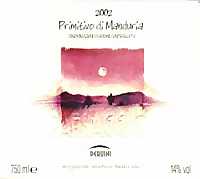
|
|
Primitivo di Manduria Pervini 2002 |
|
| Accademia dei Racemi (Italy) | |
| Grapes: Primitivo | |
| Price: € 5,60 | Score: |
| This wine shows a brilliant ruby red color and nuances of ruby red, moderate transparency. The nose reveals intense, clean and pleasing aromas that start with hints of black cherry and blueberry followed by aromas of raspberry, plum, violet and cyclamen. In the mouth has good correspondence to the nose, a slightly tannic attack and however balanced, good body, intense flavors, good tannins. The finish is persistent with flavors of black cherry and blueberry. Part of this wine ages in cask for at least 6 months. | |
| Food Match: Pasta with meat and mushrooms, Sauteed meat with mushrooms, Roasted meat | |
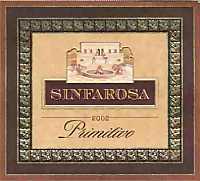
|
|
Primitivo Sinfarosa 2002 |
|
| Accademia dei Racemi (Italy) | |
| Grapes: Primitivo | |
| Price: € 6,00 | Score: |
| This wine shows a brilliant ruby red color and nuances of ruby red, moderate transparency. The nose denotes intense, clean and pleasing aromas that start with hints of black cherry and blueberry followed by aromas of cherry, raspberry, plum and violet. In the mouth has good correspondence to the nose, a slightly tannic attack and however balanced, good body, intense flavors, good tannins. The finish is persistent with flavors of plum and black cherry. This Primitivo ages in steel tanks. | |
| Food Match: Broiled meat and barbecue, Roasted meat, Hard cheese | |
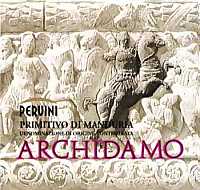
|
|
Primitivo di Manduria Archidamo Pervini 2002 |
|
| Accademia dei Racemi (Italy) | |
| Grapes: Primitivo | |
| Price: € 5,80 | Score: |
| The wine shows a brilliant ruby red color and nuances of purple red, moderate transparency. The nose denotes intense, clean and pleasing aromas that start with hints of raspberry and black cherry followed by aromas of blueberry, blackberry, cyclamen, plum and hints of vanilla. In the mouth has good correspondence to the nose, a slightly tannic attack and however balanced by alcohol, good body, intense flavors, good tannins. The finish is persistent with flavors of black cherry and blueberry. Part of this wine is aged for at least 6 months in cask. | |
| Food Match: Roasted meat, Broiled meat and barbecue, Stewed meat, Hard cheese | |

|
|
Primitivo di Manduria Felline 2002 |
|
| Accademia dei Racemi (Italy) | |
| Grapes: Primitivo | |
| Price: € 7,90 | Score: |
| The wine shows an intense ruby red color and nuances of ruby red, little transparency. The nose reveals intense, clean, refined and pleasing aromas which start with hints of black cherry and blackberry followed by aromas of blueberry, plum, violet, vanilla and pleasing hints of black pepper. In the mouth has good correspondence to the nose, a slightly tannic attack and however well balanced by alcohol, good body, intense flavors, good tannins, very agreeable. The finish is persistent with flavors of black cherry and blueberry. This wine ages in barrique for at least 12 months. | |
| Food Match: Roasted meat, Stewed meat, Broiled meat and barbecue, Hard cheese | |
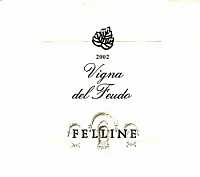
|
|
Vigna del Feudo Felline 2002 |
|
| Accademia dei Racemi (Italy) | |
| Grapes: Primitivo (34%), Malvasia Nera (33%), Ottavianello (33%) | |
| Price: € 12,30 | Score: |
| This wine shows a brilliant ruby red color and nuances of ruby red, little transparency. The nose reveals intense, clean, pleasing and refined aromas that start with pleasing hints of strawberry jam and black cherry followed by aromas of raspberry, blackberry, cyclamen, plum and vanilla. In the mouth has good correspondence to the nose, a slightly tannic attack and however balanced by alcohol, good body, intense flavors, good tannins, agreeable. The finish is persistent with good flavors of raspberry, blueberry and plum. Vigna del Feudo ages in cask for at least 14 months. | |
| Food Match: Stuffed pasta with mushrooms, Stewed meat with mushrooms, Roasted meat | |
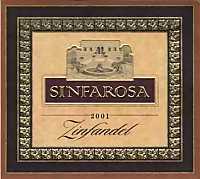
|
|
Primitivo di Manduria Zinfandel Sinfarosa 2002 |
|
| Accademia dei Racemi (Italy) | |
| Grapes: Primitivo | |
| Price: € 10,40 | Score: |
| This wine shows an intense ruby red color and nuances of ruby red, little transparency. The nose denotes intense, clean, pleasing and elegant aromas which start with hints of black cherry and plum followed by good aromas of blueberry, blackberry, violet, licorice, vanilla and hints of cocoa and black pepper. In the mouth has good correspondence to the nose, a slightly tannic attack and however well balanced by alcohol, good body, intense flavors, good tannins. The finish is persistent with pleasing flavors of black cherry, blueberry and plum. Part of this Primitivo ages in cask. | |
| Food Match: Broiled meat and barbecue, Roasted meat, Strewed meat with mushrooms, Hard cheese | |
| Accademia dei Racemi - Via Santo Stasi Primo - 74024 Manduria, Taranto (Italy) Tel. (+39) 99 9711660 Fax (+39) 99 9711530 - Winemaker: Cosimo Spina - Established: 1998 - Production: 1.200.000 bottles - E-Mail: accademia@accademiadeiracemi.it - WEB: www.accademiadeiracemi.it |
Cellar Journal |
|
This section is reserved to wine producers who want to publish news and information about their business, to announce new products or just for communicating to its customers information and promotions about their products and activity. Send news to be published at our e-mail address.
|
News |
|
In this section will be published news and information about events concerning the world of wine and food. Whoever is interested in publishing this kind of information can send us a mail at our address.
|
Cooking with WineThe famous beverage of Bacchus is not only capable of sumptuously matching the creation of cooking, it can also become a precious ally in the preparation of many and tasty recipes |
|
For wine lovers it is easy to think that in a table with lots of foods and tasty dishes is always present a good bottle of wine capable of cheering - as well as exalting and completing - the appreciation of a meal. This is certainly the idea lovers of nice food have as well - and that like cooking - however they also see the beverage of Bacchus not only in joyous glasses but also inside the pot. The idea of using wine as an ingredient for the preparation of foods is certainly not something new and there are evidences the use of wine for cooking was done since the times of ancient Rome, and before that, since Etruscan times. Wine and cooking have always made a brilliant and tasty couple since the most ancient times and their bond is still alive today also thanks to the many combinations, old and new. Documents of the past, at the time when refrigerator would have waited some centuries before appearing in the daily life of human beings, tell that wine was used as a preservative for foods and in particular for meat. Often meat was left submerged in wine for many hours, sometimes even for days, by making use of the cooking technique which arrived up to our days with the name marinade, and the same wine used for preserving the meat, as well as for flavoring it, was used as a base liquid for cooking: that's how braised foods were born. The use of wine in the kitchens of the past were not limited only to that. Ancient cookbooks clearly show the beverage of Bacchus was widely used in many cooking preparations, not only meat, but also for soups, vegetables as well as desserts and cakes.
|
|
In the course of the history of humanity, every country which produced wine was used to use it as an ingredient for cooking. Wine was frequently used for diluting sauces and as a liquid for the cooking of foods, the choice of wine instead of water seems to be more appropriate for simple organoleptic reasons. Wine, more aromatic and tasty than water, adds to foods in which it is being used its aromas and its flavors, moreover, according to the type of wine used, it also adds structure, body and color. Wine in kitchen is not only used as a liquid for the cooking of foods - even though this seems to be its most frequent case - and its use is also appreciated in the preparation of cold foods in order to add taste and aromas, last but not the least, a small quantity of alcohol as well. Wine is also frequently used for the preparation of marinades, where the food to be marinated - usually meat, but also cheese and vegetables - are left submerged in the wine for many hours, sometimes for days, or even for some weeks in case of cheese. The most frequent preoccupation about using wine for cooking is because of alcohol and there are many who believe a food cooked with wine is also alcoholic; a conviction that usually make people unaccustomed to cooking to not add any wine. Ethyl alcohol begins boiling, and therefore to evaporate, at a temperature of 78.4° C (173.12° F), therefore lower than water, a condition that would make everyone think of its total evaporation during cooking. In case of wine it is appropriate to remember alcohol usually represent about 12%-14% and it is blended with water and therefore the evaporation of alcohol is also regulated by this condition. Generally speaking it is believed that at the end of cooking wine's alcohol is completely evaporated, however recent researches have proved a small quantity of alcohol - even though negligible - can be found at the end of cooking. Moreover it must be noticed the higher the cooking time the lesser the quantity of alcohol left. The use of wine for the preparation of cold foods, of course, does not make alcohol to evaporate, therefore the quantity of wine used in this kind of recipes is pretty small. A fundamental principle about the use of wine for cooking is about its quality. Wine's aromas and flavors, as well as its structure, are added to all the other ingredients of the recipe and this is the fundamental concept about using wine for cooking. For many the wine to be mainly used for cooking is the one which is generally not considered drinkable anymore, often oxidized, with unpleasing aromas and tastes. For them the wine used for cooking represent the ultimate chance for using a bad product of low quality. Moreover there are also wines expressly sold as suited for cooking and in case are drunk alone they are absolutely undrinkable and truly bad. The quality of wine used for the preparation of foods is important and fundamental. After all, no one would like to eat a food made of rotten ingredients and having unpleasing tastes and aromas: the wine added to foods contributes to the final result with its aromas and its flavors, therefore a bad wine with evident faults adds bad aromas and flavors to food. Using very old wines does not represent, in general terms, a good choice. Not only for the economic value they could have, but also because are more appropriate and pleasing for cooking the aromas and tastes of a young wine. Of course this suggestion is to be considered as a general rule only and the use of very old wine for cooking is not excluded. When the quantity of wine to be added to a food is pretty high, such as in case of braised meat, pasta and risotto, it is good to consider the pretty acid nature of the beverage of Bacchus. Wine's acidity does not evaporate and does not diminish during the cooking process and therefore it is added to the tastes of food. Using wines having a pretty high acidity also means to add a sour and acid character to foods. In these cases it will appropriate to contrast acidity, o better to say, to make it more agreeable and less aggressive, by using ingredients with a basically sweet taste, such as fats and starches. Of course this consideration is only valid in case the typicality of the food is not of acid or sour nature.
The choice of wine to be used for cooking also depends by the type of food to the cooked, while remembering that red wine, besides adding aromas, tastes and structure to foods, also adds its color and that in some recipes could not be appropriate. In general terms white wines are used for the preparation of soups, white meat, poultry, fish, vegetables and desserts, whereas red wines are more frequently used for red meat, stewed and braised meat and sometimes for desserts as well. Both white wines and red wines are widely used for the preparation of pasta and risotto, such as red wine risotto, of which the one made with Barolo is probably the most famous one, and red wine pasta. Even sparkling wines are used for cooking: even in this case it is a risotto which represents the most common recipe, such as the renowned Champagne risotto or spumante risotto. In the preparation of this risotto it is fundamental that spumante, or Champagne, is added during cooking and not at the end: this simple trick will avoid wine's acidity to be exaggeratedly evident. Sweet sparkling wines are usually used for the preparation of desserts, fruit salads and dessert creams. Sweet wines offer interesting and surprising possibilities in cooking and not only in the preparation of desserts, as it could be easily thought. Sweet wines can be well matched with recipes of red meat and, in particular, with cheese. After all, it should be remembered, in past times it was this type of wine to be used more frequently in the recipes of ancient Greeks, ancient Romans and Etruscans. At those times they used to add sweet wines to pretty robust meats, such as game, and the higher structure of these wines, as well as the copious use of condimental and aromatic herbs, was well matchable to meat. The use of sweet wines in the preparation of foods made of meat is still common today and in many stewed meats is advised the adding of a glass of sweet or botrytized wine. Sweet wines used in pastry cooking always add class, elegance and finesse both to creams and to baked cakes. A special mention should be done for fortified wines such as Porto, Jerez (Sherry), Málaga, Madeira and Marsala. These wines, besides being excellent to taste, are also precious allies in cooking, always ready to add extraordinary aromas and tastes to the foods in which are being used. Fortified wines add an incomparable “special touch” to soups and broth, they are extraordinary ingredients for the preparation of foods made of meat, add a wonderful taste to sauteed foods. Try, for example, to add a small glass of Marsala, preferably superiore riserva, but also a small glass of Madeira or Porto, in the pot where the broth is boiling. Or try to add a glass of good Marsala, instead of white wine, to the toasted rice to be used for risotto. A good example of cooking that makes use of a fortified wine is offered by the famous Marsala scallop. In this recipe, simple and quick to prepare, its main and characteristic taste is because of the use of Marsala during cooking. The same recipe would be less tasty in case a less complex and rich wine than Marsala, or other fortified wines, would have been used instead. Talking about wine and broth, in some Italian regions still exists an ancient tradition which suggests to add two spoonfuls of red wine to one's own bowl of soup, and when there was no red wine, two spoonfuls of white wine. This is, as a matter of fact, a simple but efficient way to add flavors to a food and the taste is certainly agreeable even though, it seems, not everyone likes it. An alternative to red wine is wonderfully represented by Marsala - or any other fortified wine - that will add to the soup richer aromas and tastes. Wine is also used for the preparation of sauces to be used as a condiment for foods, in particular for the ones made of meat. Generally wine sauces require the use of thickening ingredients - such as potato flour, wheat flour or corn starch - and during their preparation particular attention will be paid on cooking to be done slowly and the boiling point will never be reached. This trick will avoid the sauce to have less pleasing tastes and the wine to lose its aromatic freshness and flavors. Wine is particularly used in the preparation of marinades, that is those liquids in which are left submerged, often completely submerged, many ingredients, in particular red meat and game. The preparation of marinades makes use, besides of wine, which can be white and more frequently red, of other ingredients as well in order to add more aromas and flavors to the food. Typical ingredients that complete wine in the preparation of marinades - in particular in Italian cooking - are rosemary, sage, laurel, fennel seeds, black pepper grains, clover and sometimes lemon juice. The ingredients and the type of wine used for the marinade vary according to the type of cooking. After the marinading time has passed, the food is cooked without eliminating the liquid which will contribute to aromatize the food. This technique, common in the preparation of braised meat, will also make a tasty and succulent sauce to be used for the condiment of the food. The slow cooking, typical for these kind of preparations, allows a slow evaporation of water with the result of concentrating and thickening the marinading liquid which in turn will be enriched with other flavors. The slices or the pieces of meat cooked this way are always enriched in the dishes with generous spoonfuls of the cooking liquid.
|
||||||||||||
|
At the end of “kitchen works” finally come the great moment of serving in the table the results of those magic alchemy called “cooking”. Which wines should be chosen for the foods prepared with the beverage of Bacchus? A famous rule suggests to use the same wine used for the preparation of that food and this is always, in general terms, a very good choice. A Barolo braised meat, for example, should be preferably matched to the same Barolo. This simple rule is confirmed by facts as the flavors of wine used for the making of the food will be in perfect harmony with the same wine poured in the glass. In this way, as a matter of fact, will be reinforced the aromatic and gustatory character of the wine used in the food. In case it is not possible to match the food with the same wine used for its preparation, the best alternative is to choose a wine having similar characteristics. For example, in case a robust red wine was used for cooking, it is good to choose a wine having the same body. The same applies to white wines. In case an aromatic wine was used, it is good to choose a wine having at least the same aromaticity, otherwise it will be the food, with its aromas, to prevail over the wine. In other words, the result will be a wrong matching according to an enogastronomical point of view. Another consideration should be done for fortified and sweet wines used for the preparation of salty foods. In case it is not wished to match the same wine, even though this could be a good idea, it will be appropriate to choose a wine, white or red according to the food, having a good roundness and aromatic complexity in order to “compete” with the rich aromas and flavors of the sweet or fortified wine. Enjoy the meal!
|
CalvadosThe brandy obtained by a particular variety of apples produced in the French region Normandy is among the most famous distillates of the world |
|
In 1588 the king of Spain Philip ordered his fleet to head to English coasts. One of the ships, the “El Salvador”, accidentally shipwrecked in French coasts. The reason of the shipwreck is not known, maybe because of the crew, or maybe because of the content of the hold, anyway, the legend goes that from that moment on the place of the shipwreck as well as the neighboring region was called Calvados. But this is just a legend.
|
|
Since immemorial times apple trees prospered in the northern region of France called Normandy. Documents left by indigenous people, Celts and Romans, tell us about a region where apple trees prospered both as a wild tree, because of the ideal climate and territory suited for its natural development, and as a sacred tree. From the thirteenth century on, the old and big trees, spread everywhere in the region, were slowly replaced by other varieties: cyder apples (pommes à cidre). The indigenous varieties were replaced by other species called “Bisquet” and “Marin Onfroy”, certainly suited to bear fruits for the production of cyder. The natural landscapes of the region begins to change. In traditional Norman landscapes, where cows graze in the grass and among the high apple trees, takes place a progressive change and the grasses are particularly cared because they must be very soft in order to attenuate the falling of apples. The high trees are replaced by specialized varieties with a low trunk. The ancient landscape is certainly disappeared, however, not everything is lost. In springtime the landscape is characterized by thousands and thousands blossoming trees, and in autumn, when the fruits are ripe, the aromas permeates the air. Probably the best seasons to visit Normandy are autumn and spring. The production of cyder, once called Sydre and then Cidre, begins to develop until getting to a relevant importance in all the Norman region and therefore it spreads all over France. The origin of Calvados is certainly ambiguous. By reading old documents it can be found the first evidence about the distillation of cyder: March 28th, 1553. This information was found in the diary of Monsieur De Gouberville, a member of the nobility and expert gastronomer, who lived in Mesnil Au Val, in the peninsula of Cotentin in the English Channel, and despite the fact he mentioned the distillation of cyder, he did not say whether it was a common practice or a new technique. Some years later, in 1600, it was established the “Corporation of distillators of cyder brandy”. The name of the distillate derives from the area where it is produced. The region of Normandy called “Calvados” seems to be named like that because of the legend about the shipwreck of “El Salvador” ship that we already mentioned. In the beginning the spreading of the brandy was limited to the area of production but after the liberalization of trading, around the end of the 1700's, the Brandy of Calvados began to spread and became very popular in the capital Paris, where, with time, changes both its name in “Calvados”, and its destiny, becoming one of the most appreciated and famous brandies. In 1942 Calvados is recognized as AOC (Appellation d'Origine Contrôlée, Appellation of Controlled Origin), and in 1963 it was revised and were strictly set both the area and the methods of production as well as the type of alembics. Moreover were also set some norms concerning the finished product: before being commercialized, Calvados must receive the authorization by the Commission de Dégustation de l'Institut National des Apellation d'Origine (INAO), which verifies the fulfillments of every requirement as set by law.
|
||||
|
Everything begins with cyder apples and do not imagine sweet and tasty apples. Cyder apples are not suited for consumption, their botanical origin is different from edible apples. There are hundreds of varieties of cyder apples, each one of them having its characteristics, however the varieties legally permitted for the production of cyder are fortyeight. Basically apples are classified in four groups: sweet, bitter, sweet/bitter and sour. To obtain a good quality cyder it is necessary to use different varieties in order to have a harmonious result. Sometimes can also be used pears in order to increase or to have the desired acidity. In general terms the ideal blending is as follows: 40% of sweet apples, 40% of bitter apples and 20% of sour apples. The preparation of cyder is made by scrupulously selecting apples, therefore the juice is being extracted by washing and pressing the fruits. The juice, that according to laws must be exclusively produced by fresh fruits, is being fermented for about three months, the necessary time in order to develop the right aromas, therefore it becomes cyder for distillation. This phase, just like the others, is very important: a good Calvados can be made only in case a good quality cyder was used.
The cyder must meet strict requisites: it must have at least 4.5% of alcohol, the adding of sugar is severely forbidden and the volatile acidity must be lower than 2,5 grams/liter. This requisites are valid for every type of Calvados. There are two types of Calvados: Calvados AOC and Calvados AOC du Pays d'Auge. “Calvados AOC du Pays d'Auge” must be produced with apples cultivated in the area called “Pays d'Auge” (see figure ), the fruits are processed inside this small area, finally, the cyder is distilled for two times by using an alembic similar to the one used for the distillation of Cognac. Concerning the “Calvados AOC”, apples must come from the area outside the “Pays d'Auge” (see figure ), and distillation must be done in a simple distillation alembic, also known as column alembic. Just like “Calvados AOC du Pays d'Auge”, produced in its typical area, also the rest of Calvados AOC area has its niches and peculiarities. Every area has different varieties of plants, a presence of cyder pears in different quantities as well as different environmental characteristics. These conditions, just like in wines and in other distillates, give origin to a number of products different one from each other even though produced with the same rules set by the production disciplinary. The distillation of cyder for the production of “Calvados AOC du Pays d'Auge” is done for two times by using an alembic similar to the one used for Cognac. The first phase of distillation is called première chauffe, from which, by eliminating the “head” and the “tail”, is obtained the acquette or brouillis. The second distillation, called bonne chauffe, uses the product of the first phase, and after having eliminated the head and the tail, it is obtained the brandy called Calvados, that can be considered as such only in case it has a percentage of alcohol lower than 72%. The alembic used for “Calvados AOC du Pays d'Auge” is made of 6 elements. The heater is the generator of heat which is gas or wood operated. The boiler, rigorously made of copper, contains the cyder to be distilled. The dome, located on the top of the boiler, let only the lightest steams to pass and avoids the foam to enter the cooling system. In the cyder heater the steams coming from the boiler, and before entering the cooler, pass for a container that pre-heats the cyder for the next distillation phase in order to make the system more efficient. The waiting cyder, held in this container, is heated at a temperature which is equal to 5 hours of heating in the boiler. The cooler, by cooling the steam down, allows the distilled liquid to be collected in a final tank. “Calvados AOC” is distilled in a column alembic and only for one time. The column alembic is made of three elements: the boiler, the first column and the concentration column. The boiler is the container in which the cyder is being boiled and from which passes to the superior part of the first column. This column receives the cyder in its higher part and it allows the cyder to flow down, along its lower plates, slowly and in order to make it release all of its aromas. Steams are then directed to the concentration column where the head and the tail of the distillate are being eliminated, they are then cooled therefore producing a brandy with a maximum percentage of 72% of alcohol. This is where the first phase of production of Calvados ends. Exactly like other brandies, the phase of aging completes, improves, refines and enriches the product obtained by distillation.
|
||||||||
|
For the aging of Calvados are being used casks of Norman oaks, made with very dry wood. The cask, when receives the young distillate, begins to pass its tannins therefore giving aromas, color, roundness to the brandy. The golden color of a young brandy slowly changes into a more and more intense gold or amber color, losing the aggressivity which characterizes a young brandy without lowering its strength. Moreover the porosity of wood allows the evaporation of a small part of the brandy, small but certainly not insignificant. Another aspect to be considered during the phase of aging is the role played by the air, or more precisely by oxygen. The oxidizing effect of the air in cellars, an air at a right temperature and humidity, greatly contributes to the physical and chemical evolution of Calvados, allowing the brandy to get more and more complex aromas. During the aging phase the percentage of alcohol lowers from about 70% to 40-45%. Every cellar has its cellar masters that with their knowledge and experience, try to take advantage of this processes in order to make the product they had in mind. There are many variable and endless possible combinations: distillate, wood, air, temperature, humidity and time. All these variable are measured, controlled, verified and corrected. Aging does not mean abandoning the distillate in the cellar. At the end of aging takes place the last phase preceding bottling: blending. Just like a chemist, an alchemist of the past, the cellar master proceed to the blending of many types of Calvados. The brandies coming from different areas and vintages are blended in order to create the final product destined to the consumer. There are many types of Calvados, however they are classified in two types: vintages and blends. A vintage Calvados is produced with only one distillate produced by the same distillation process of the specified year. Blended Calvados, produced with different brandies, the age written in the label represents the age of the youngest brandy. For example, in a 30 years old Calvados the youngest distillate in the blend is a 30 years old brandy, however it can also contain older brandies. The following is a list of the many denominations found in Calvados labels:
Sometimes in the labels is shown the year of bottling: this is an important information because every brandy, after bottling, ends its evolution. Generally young Calvados are used for the preparation of cocktails and long drinks, whereas aged Calvados are usually tasted alone and in meditation, or at the end of a meal. Calvados is a good digestive, French love having it even during meals, in the short time of waiting between courses. The best glass for tasting Calvados is the classic Cognac glass.
|
Wine Parade |
|
|
| The best 15 wines according to DiWineTaste's readers. To express your best three wines send us an E-mail or fill in the form available at our WEB site. |
| Rank | Wine, Producer | |
|---|---|---|
| 1 |
| Alto Adige Gewürztraminer Kolbenhof 2002, Hofstätter (Italy) |
| 2 |
| Margaux 2000, Ségla (France) |
| 3 |
| Franciacorta Cuvée Annamaria Clementi 1996, Ca' del Bosco (Italy) |
| 4 |
| Syrah Winemaker's Lot Vic 3, Concha y Toro (Chile) |
| 5 |
| Turriga 1998, Argiolas (Italy) |
| 6 |
| Fumé Blanc Napa Valley 2001, Grgich Hills (USA) |
| 7 |
| Amarone della Valpolicella Classico Capitel Monte Olmi 1999, Tedeschi (Italy) |
| 8 |
| Barolo Brunate 1999, Enzo Boglietti (Italy) |
| 9 |
| Anjou 2001, Domaine de Montgilet (France) |
| 10 |
| Rioja Reserva Era Costana 1999, Bodegas Ondarre (Spain) |
| 11 |
| Masseto 1998, Tenuta dell'Ornellaia (Italy) |
| 12 |
| Barolo Cicala 1999, Poderi Aldo Conterno (Italy) |
| 13 |
| Colli Bolognesi Pignoletto Superiore “Prova d'Autore” 2001, Bonfiglio (Italy) |
| 14 |
| Sauvignon Blanc Reserve Marlborough 2002, Kaituna Hills (New Zealand) |
| 15 |
| Capo di Stato 1998, Conte Loredan Gasparin (Italy) |
| |||||||
Privacy Policy | |||||||


| Copyright © 2002-2024 Antonello Biancalana, DiWineTaste - All rights reserved |
| All rights reserved under international copyright conventions. No part of this publication and of this WEB site may be
reproduced or utilized in any form or by any means, electronic or mechanical, without permission in writing from DiWineTaste. |